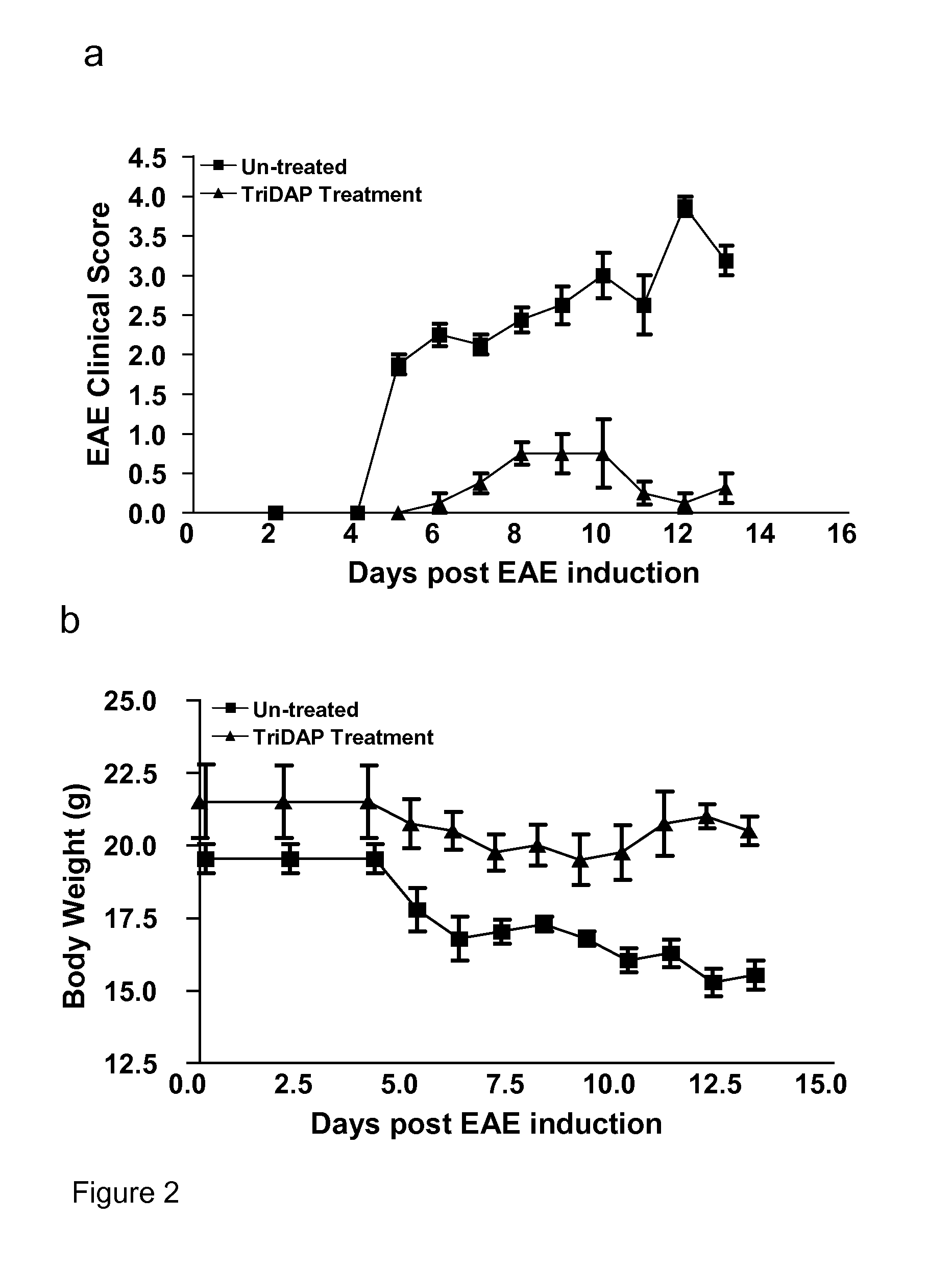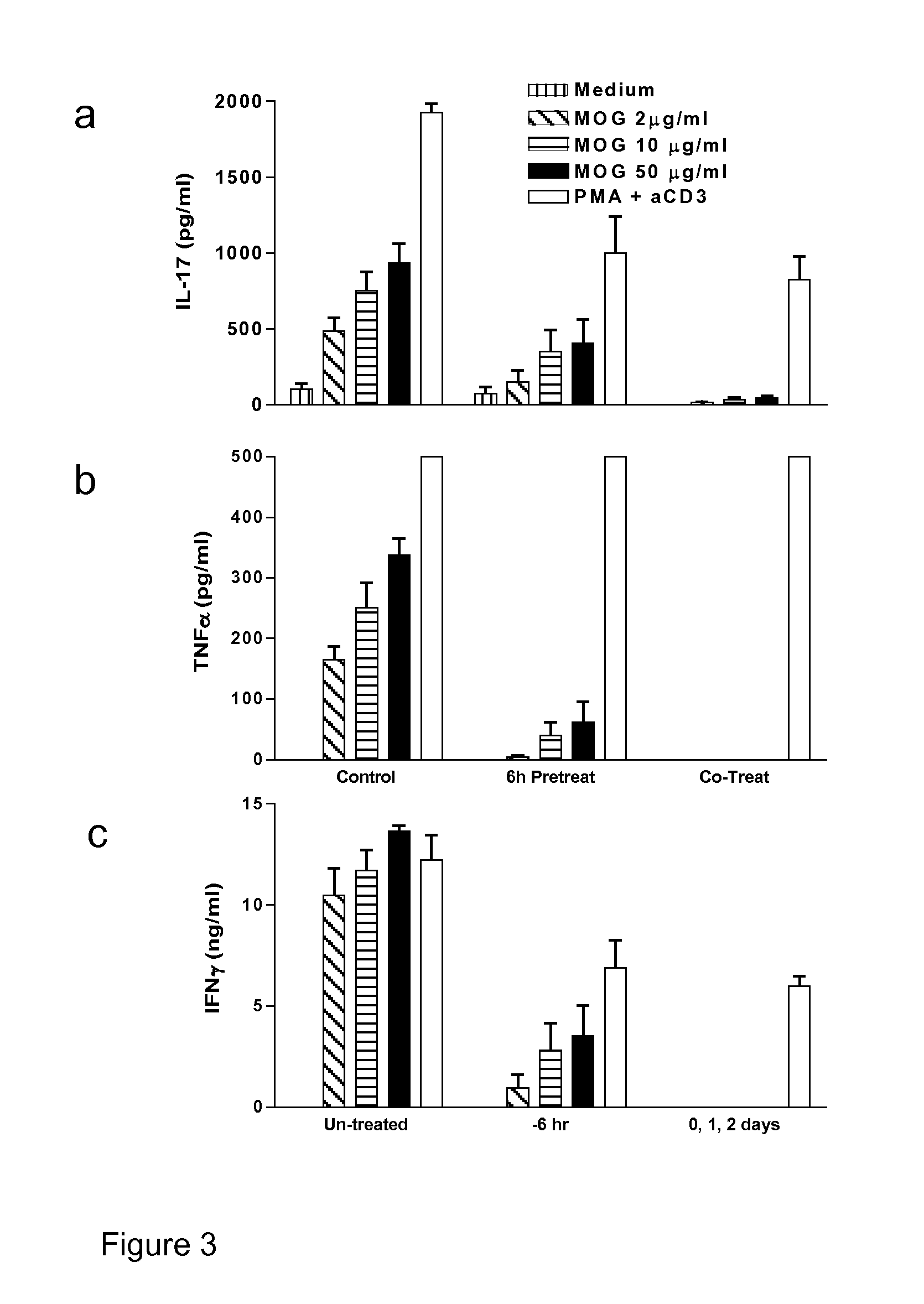Compounds and methods for the treatment of autoimmune and inflammatory disease
a technology for applied in the field of compound and method for the treatment of autoimmune and inflammatory diseases, can solve problems such as undesirable side effects, and achieve the effect of less effective in inducing t cell activation
- Summary
- Abstract
- Description
- Claims
- Application Information
AI Technical Summary
Benefits of technology
Problems solved by technology
Method used
Image
Examples
example 1
Treatment with the NOD1 Agonist Tri-DAP Attenuates Experimental Autoimmune Encephalomyelitis (EAE)
[0128]This experiment was designed to identify whether Tri-DAP treatment could reduce the clinical score of disease severity following induction of EAE in mice.
Material and Methods:
[0129]EAE was induced in C57BL / 6 mice by subcutaneous (s.c) injection with 150 μg of MOG35-55 in CFA supplemented with 4 mg / ml H37 Ra M. tuberculosis on day 0. All mice were injected intra-peritoneally (i.p) with Pertussis toxin (PT) on days 0 and 2. One group of mice were untreated and the second group were given Tri-DAP (100 μg / mouse) on day 0 in MOG / CFA emulsion and again on days 1, 2 and every 2 days thereafter. Clinical scores were assessed daily and body weights were recorded. Disease severity was graded as follows: grade 0: normal, grade 1: limp tail, grade 2: wobbly gait; grade 3: hind limb weakness; grade 4: hind limb paralysis; grade 5: tetraparalysis / death. † indicates control mice were sacrificed ...
example 2
Treatment with the NOD1 Agonist Tri-DAP Suppresses MOG-Specific Inflammatory Cytokines Following EAE Induction
[0132]This experiment was designed to determine the effect of Tri-DAP treatment on the production of Th1 and Th17 specific inflammatory cytokines following EAE induction.
Materials and Methods:
[0133]EAE was induced in C57BL / 6 mice by s.c injection with 150 μg of MOG35-55 in CFA supplemented with 4 mg / ml H37 Ra M. tuberculosis on day 0. All mice were injected i.p with PT on days 0 and 2. One group of mice were untreated, the second group were given 100 μg Tri-DAP 6 hours before immunization and a third group were given Tri-DAP (100 μg / mouse) on day 0 in MOG / CFA emulsion and again on days 1, 2 and 4. Mice were sacrificed on day 5 and lymph nodes cells were stimulated with MOG peptide (Myelin oligodendrocyte glycoprotein) (20-100 μg / ml) or as negative and positive controls, medium only or PMA and anti-CD3 respectively. After 72 hours supernatants were removed and analyzed for IL...
example 3
Treatment with the NOD1 Agonist Tri-DAP Suppresses IL-17-expressing and IFNγ-Expressing T Cells in the Brains of Mice with EAE
[0136]This experiment was designed to determine the effect of Tri-DAP treatment on various IFN-γ and IL-17 producing T-cell populations in the brains of mice following EAE induction.
Materials and Methods:
[0137]Mononuclear cells were isolated from the brains of control EAE or Tri-DAP treated EAE mice 12 days post EAE induction. Cells were restimulated overnight with PMA / ionomycin and incubated with Brefeldin A. Cells were stained with anti-CD3 (FIG. 4), or anti-CD3 and anti-CD4 (FIGS. 5 and 6). Cells were then fixed and permeabilized, stained intracellularly with anti-IFN-γ and anti-IL-17 and analysed by flow cytometry.
Results:
[0138]In all T-cell populations examined (CD3+ cells in FIG. 4, CD3+ CD4+ cells in FIG. 5 and CD3+ CD4− cells in FIG. 6) Tri-DAP treatment suppressed IFN-γ and IL-17 production (FIGS. 4-6).
[0139]These results demonstrate that treatment w...
PUM
| Property | Measurement | Unit |
|---|---|---|
| Magnetic field | aaaaa | aaaaa |
Abstract
Description
Claims
Application Information
 Login to View More
Login to View More - R&D
- Intellectual Property
- Life Sciences
- Materials
- Tech Scout
- Unparalleled Data Quality
- Higher Quality Content
- 60% Fewer Hallucinations
Browse by: Latest US Patents, China's latest patents, Technical Efficacy Thesaurus, Application Domain, Technology Topic, Popular Technical Reports.
© 2025 PatSnap. All rights reserved.Legal|Privacy policy|Modern Slavery Act Transparency Statement|Sitemap|About US| Contact US: help@patsnap.com



